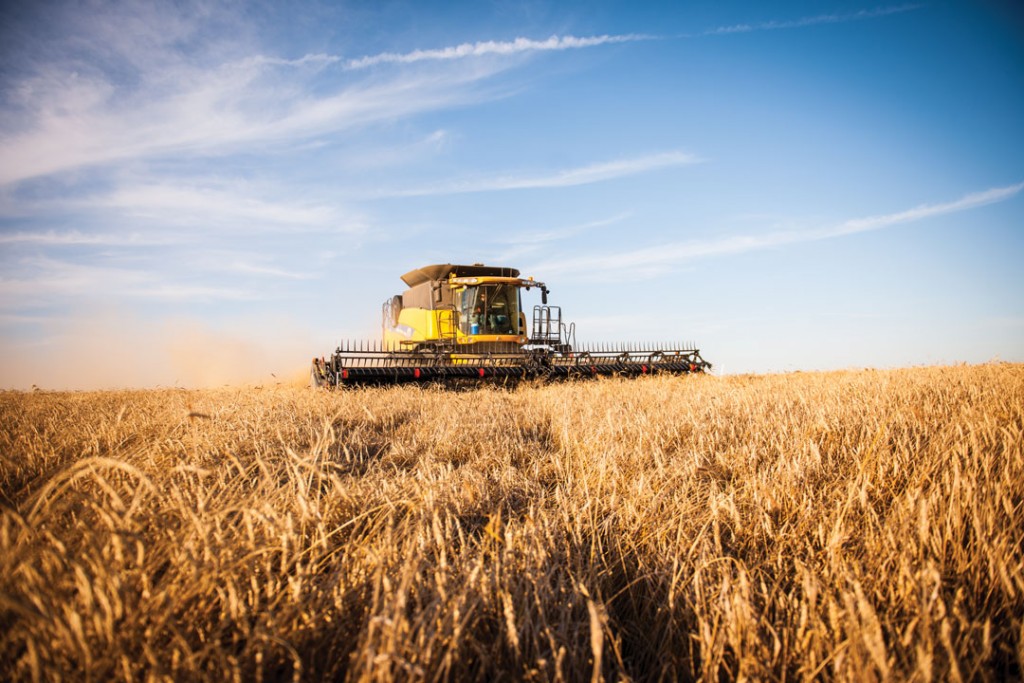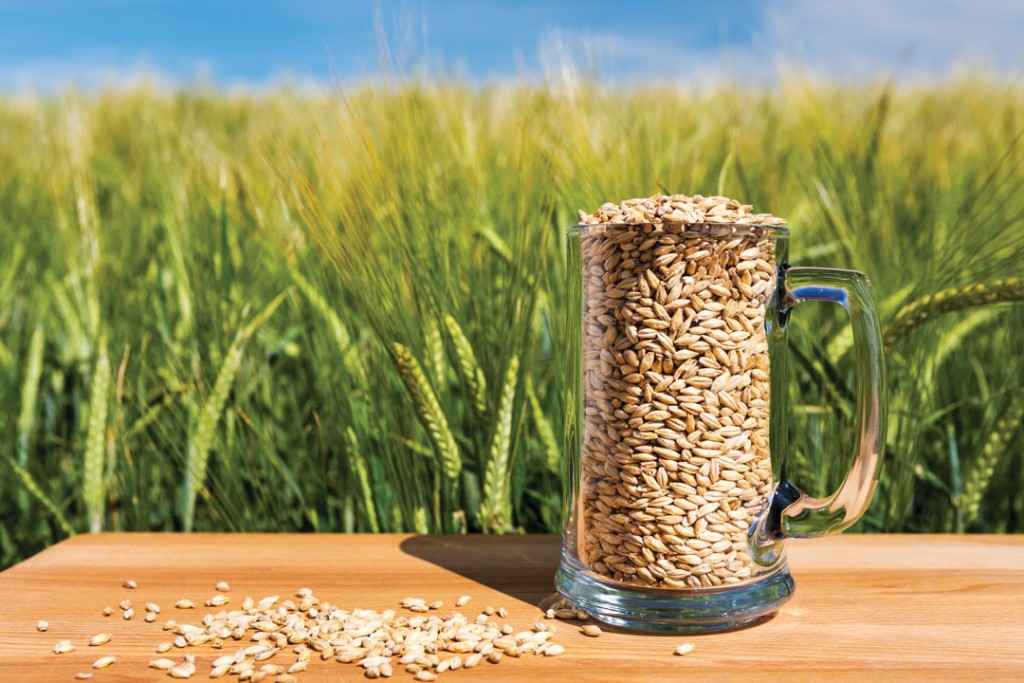THE FARM GATE
CLASS ACTION
Wheat talk stirs up the chaff
BY LEE HART
Everyone wants the world to recognize Canada as a producer of high-quality wheat. Not everyone agrees that moving 29 well-established wheat varieties into a new, currently unnamed class is the right way to go.
The Canadian Grain Commission (CGC), which launched the reclassification review earlier this year, said the process will increase confidence among domestic and international customers looking for high-quality milling wheat. However, some western farmers and industry associations see it as a move that will essentially bench several valuable varieties, reduce the choices available to farmers and create an expensive logistics issue at all levels.
In February 2015, the CGC announced it was launching a wheat reclassification consultation. The CGC proposed that new check varieties be established for the Canada Western Red Spring (CWRS) and Canada Prairie Spring Red (CPSR) classes to improve the quality parameters of those classes. It would then evaluate all existing varieties and any that no longer met the standards would be moved to another class. The Commission also proposed the establishment of a new Western Canada milling class.
In August 2015, the CGC announced, after industry consultation, that 29 wheat varieties had been identified for reclassification. That included 25 varieties—many of them well known—in the CWRS class and four varieties in the CPSR class. The plan is, after more input from industry players, to reclassify these 29 varieties from their respective ranks and place the majority of them in the new class. The 29 varieties would remain in their respective classes until Aug. 1, 2017.
The reclassification is necessary to “maintain customer confidence in Canadian wheat quality,” said Jim Smolik, assistant chief commissioner at the CGC. Virtually all of these varieties just barely met the quality standards for the class when they were originally registered, said Smolik. New, improved check varieties have come along, and quality parameters are always being reviewed. With the environmental conditions seen in recent growing seasons, some of the varieties are always at the bottom or don’t even meet the CWRS and CPSR quality standards.
“With our CWRS wheats, gluten strength is one important factor,” said Smolik. “And customers are looking to Canada to supply wheat with a consistent quality.” If these lower-quality wheats affect customer confidence, it affects Canada’s wheat-marketing efforts. Farmers will still be able to grow the reclassified wheat varieties, and Smolik pointed out they may have an excellent fit in new and emerging world markets for products such as pan breads and noodles.
There has been a range of reactions to the reclassification proposal.
The Western Canadian Wheat Growers Association agrees with the plan. “The Wheat Growers support the move by the Commission to restore the quality and integrity of the top milling classes of wheat,” said Levi Wood, president. “This move should address concerns expressed by customers in the past several years regarding the low gluten strength in Canadian wheat shipments.”
Cereals Canada, which represents a cross-section of the grain industry, including producers, processors, shippers, handlers and seed companies, said the intention to protect Canada’s quality wheat reputation is good. But its president, Cam Dahl, said Cereals Canada believes that creating another class will raise a logistics nightmare on the handling side and that “costs will outweigh the benefits.”
From a producer’s point of view, Henry Vos, who farms at Fairview and is a director of the Alberta Wheat Commission (AWC), doesn’t like the plan at all. “I am not very impressed with how this has been handled,” said Vos. “Farmers have been growing some of these varieties for 50 years, and we’re just saying now they don’t have CWRS quality? This doesn’t make sense.”
Vos said it should be up to the value chain—including producers, marketers and customers—to decide what to do with these wheats, and not a regulatory bystander such as the CGC.
He said reclassifying these wheats will remove 29 varieties from producer options and remove a lot of good wheat genetics and agronomics from Western Canada. “As this goes ahead, we won’t need a new classification,” he said. “Because the perception now of these 29 varieties is that they are lower quality. It will be an excuse for grain companies to lower prices. No one will grow [the varieties], and eventually [they] will drop from the market.”
AWC favours a natural phase-out of the varieties over time and questions whether they are having a material impact on the quality of Canadian shipments. AWC also contends that insufficient market development work has been done to support a new milling class.
G3 EXPANDS EXPORT POTENTIAL
Plans for a new terminal could open up eastern markets
BY TAMARA LEIGH
With the rebranding of the Canadian Wheat Board complete, G3 Canada Limited has announced expansion plans that will solidify its network in the East and create a new, more robust grain-transportation corridor to the West. The investment, including the development of a new grain terminal at Port Metro Vancouver, is expected to ease the bottleneck of moving grain to new markets, including Asia and the Middle East.
“We are currently looking at the feasibility of building a facility in North Vancouver on a piece of land that we feel is one of the best, and possibly last, deep-water port sites in Vancouver,” said Karl Gerrand, chief executive officer of G3. “If we are successful, it will be the first new grain terminal built in Canada since the late 1960s and a complete step change from the way things are currently done.”
Plans for the terminal include a loop track with the capacity to have three 130-car unit trains on site at a time and to unload a unit train in less than six hours. The new terminal will increase efficiency, alleviate the current bottleneck and create capacity for third-party grain shipments to international markets such as Saudi Arabia.
To support the new terminal, G3 is planning to build six to eight inland terminals in Alberta and Saskatchewan. Locations have yet to be announced.
“Our target throughput for the new [Vancouver] facility will be six million tonnes per year. We expect to do four million tonnes ourselves, and the other two million will be available to other companies,” said Gerrand.
That additional capacity is music to the ears of Nicole Rogers of Agriprocity, a company that specializes in matching Canadian grain growers with contracts from processors in the Middle East. “For us, the G3 expansion means we’ll have an exit in Vancouver,” said Rogers. “With the new terminal, they’ll probably be more open to a longer-term handling agreement, something our buyers in the Gulf are looking for. The inland grain companies have no motivation to do that.
“What’s great about having a Gulf entity own bricks and mortar in Canada is that [its] focus is the exact same as [that of] our buyers,” added Rogers.
SALIC, the Saudi Agriculture & Livestock Investment Corporation, is a partner in G3, along with Bunge Canada. Owned by the Saudi government, SALIC invests in agricultural, livestock and associated value chains around the world to help improve food security.
THIMET GETS SECOND LOOK
BY GRIFFIN ELLIOT
New research out of Montana State University (MSU) shows that Thimet, a pesticide previously banned in Canada, can be more effective at controlling wheat-destroying pests if applied differently.
Thimet, a product made by the Amvac Chemical Corporation, is an organophosphate pesticide that can be used to control wheat-stem sawfly infestations. The wasp-like insects destroy wheat stalks from the inside out.
David Weaver, a Canadian professor of entomology at MSU, is involved in the new Thimet research. He said that, based on his team’s findings, a grower can “boost the activity of Thimet by decreasing the time window that passes between when the product is taken up and when the wheat-stem sawfly adults infest the wheat.”
In May 2004, Health Canada’s Pest Management Regulatory Agency (PMRA) decided to phase out the sale and use of Thimet 15-G, “based on risks to birds, mammals and aquatic organisms from exposure to the granular product.”
The PMRA set a deadline of May 1, 2015, for the last sale of Thimet 15-G by distributors and retailers, and a deadline of Aug. 1, 2015, for its last use by growers. In Canada, Thimet 15-G was primarily used to reduce wireworm damage in potato crops, and the ban has left many potato growers scrambling to find alternatives for wireworm control.
“For most of the targeted pests, there were better products to use and, specifically, Thimet is an older organophosphate. It happens to be very systemic, which is why that activity works against wheat-stem sawfly larvae,” Weaver said. “It’s a restricted-use [product] because of [its] high oral, dermal and inhalation toxicity.”
The research Weaver is involved in shows that if Thimet is applied to crops post-emergence, one inch below the soil surface, the wheat stalks have enough time to take up the chemical and expel it by harvest. This can be accomplished within the legally established and labelled pre-harvest interval of 85 days or more.
Since Thimet 15-G was banned in Canada, Amvac has come out with a new formulation of the pesticide called Thimet 20-G. According to Weaver, the only difference is a higher concentration in the granules. Thimet 20-G allows farmers to apply at a rate of five pounds of product per acre, the existing legal tolerance for wheat. For large crop areas, the higher amount of active ingredient per pound is an asset to growers.
Weaver said historical Thimet trials might have also shown that the product may be successful in controlling wireworm and spiral nematodes, but more research will have to be done into the effects of this use. Due to the timing of activity of key wheat stem sawfly biological control agents, there is no evidence of any negative direct effects on parasitoids that attack large wheat-stem sawfly larvae.
A former graduate student at MSU who tested the product on his own wheat crops spurred the new look into the pesticide. Weaver explained that the effects of wheat-stem sawfly infestations are much more detrimental for growers in Montana than for those in Western Canada. On the Canadian Prairies, wheat stem sawfly numbers have declined since the early-2000s. The decline is likely the result of fluctuating weather patterns, growing natural enemy populations and the use of diverse crop rotations.
Amvac has submitted an application to the PMRA for Thimet 20-G to be approved for use in Canada, as well as an application for the reinstatement of Thimet 15-G. Grower groups, such as the Prince Edward Island Potato Board, support the reinstatement of Thimet 15-G.
GROWING FORWARD
CSTA president Scott Horner looks ahead to a year of opportunity
BY NATALIE NOBLE
The current Canadian agricultural environment is filled with optimism and a new perspective of increased prosperity. However, Scott Horner, 2015/16 president of the Canadian Seed Trade Association (CSTA), said there’s still more to do.
“I think every president comes into their term thinking their year is an important one. I’m no different,” said Horner. “My goal for this year is to create tangible progress in improving the environment for investment and innovation in our industry so that significant value creation can occur for all stakeholders.”
With the privatization of the Canadian Wheat Board, improvements to Canada’s crop variety registration system, and the ratification and implementation of UPOV 91, the stage has been set to promote investment in research and the development of new seed varieties, thus ensuring that Canada stays internationally competitive. No doubt Horner will be a major player in continuing this momentum.
“Horner has a good understanding of the many moving parts of the seed industry,” said Peter Entz, the CSTA’s 2013/14 president. “His broad background of experience and his methodical way of thinking put him in good stead for any challenges that may arise.”
That background includes being born and raised on a farm near Creelman, SK, where Horner’s family raised Black Angus cattle and grew mostly cereal crops. After earning his bachelor of science in agriculture from the University of Saskatchewan, Horner went on to work with Zeneca Seeds, which later went global as Advanta Seeds.
Horner has appreciation for his time with Advanta, where he got to know seed growers and farmers from all corners of Western Canada. “It was a great start to my career as well as valued learning, insight and experience with Canadian agriculture. I developed a lot of great relationships [that] I still value today.”
In 2001, Horner came on as the third employee at HyTech Production Ltd., near Coaldale, and he is now part owner and general manager. Horner has managed the independent, contract seed-production company to its present state, with operations in Chile, southern Alberta, British Columbia and Washington. “I was looking for new challenges and the chance to play a greater role in a seed business. I saw an opportunity to help build a seed-production company that could become an industry leader and service western Canadian producers,” he explained.
Horner joined the CSTA’s board of directors in 2008 and now represents the association on the board of the Seed Association of the Americas (SAA). He’s also been chair of the SAA’s International Committee and Hybrid Canola Seed Production Subcommittee.
With all the forward motion in the seed industry, Horner will lead the CSTA to ensure that progress continues. As the variety registration system is modernized, many CSTA members will be actively monitoring and commenting on the new system to streamline the process and encourage efficiency and innovation.
One of the most anticipated initiatives this year has been the execution of UPOV 91. “There has already been recognition of the new environment we’re operating under now,” Horner pointed out. “The Plant Breeders’ Rights Office announced a 20 per cent increase in the number of applications since UPOV 91 came into effect. Breeders are seeing the benefits of having their varieties protected under UPOV 91.”
Other groundbreaking developments related to the implementation of UPOV 91 include Canterra Seeds’ joint venture with Limagrain on July 2 and minister Gerry Ritz’s July 8 announcement of collaboration between Agriculture and Agri-Food Canada, Canterra Seeds and the Alberta Wheat Commission. These initiatives highlight the importance of public-private-producer investment to Canada’s future.
Still, Horner looks forward to even more industry success. “As an association, we’re focused on ensuring a favourable environment, regulatory support and intellectual property protection to encourage investment, innovation and development.”
ID, PLEASE
Identifying malt varieties using genetic markers
BY KARIN OLAFSON
Developing protein profiles is a common way to distinguish malting barley varieties. However, it is not always the most efficient method. Aaron Beattie, PhD, an assistant professor at the University of Saskatchewan and a barley breeder at its Crop Development Centre, is leading a project to develop a new, more efficient way to identify and distinguish malting barley varieties.
Since April 2014, Beattie and his team have been developing a SNP (single-nucleotide polymorphism; pronounced “snip”) marker technology that quickly, efficiently and effectively identifies malting barley varieties. In a nutshell, Beattie’s research differentiates one barley variety from another by finding one key difference in its genetic makeup.
“SNP markers are differences within the DNA sequence between different variants of barley,” explained Beattie. “In this project, we’re interested in identifying any kind of difference in the DNA sequence between the barley varieties.”
The project began with Beattie and his team collecting pure seed of malting barley varieties from breeders and companies representing them. Part of the varieties’ genome was sequenced, and the main scientist on the project, Tajinder Grewal, began working his way through the data to identify SNPs specific to each malting barley variety. There will always be one SNP marker that is unique to each variety, making differentiation easy.
“You could think of this as a Human Genome Project for barley,” said Beattie. “In that project, they’re looking at genetic differences between people. We’re doing the same thing in barley, although only analyzing a portion of the genome rather than the whole barley genome.”
This works much like a naming system. The hope is that a unique SNP marker will be identified for all—or as many as possible—of the 10 malting barley varieties on the Canadian Malting Barley Technical Centre’s list of recommended malting barley varieties.
According to Beattie, the ultimate goal of the project is quality assurance. “Canada has a reputation for high-quality barley, and this ties into maintaining that high-quality standard that we have,” said Beattie. “I think if both the customers in Canada and the farmers in Canada have more confidence in what they’re buying and selling from one another, it will make the whole system work a little bit smoother.”
Todd Hyra, business manager of SeCan Western Canada, is also enthusiastic about what the research means for the Canadian barley industry.
“The faster and more efficiently we can identify and distinguish products in grain cargos, the better off our industry overall is,” said Hyra. “When our customers get a better product because we’ve got a system that’s backed by an efficient measurement system, such as the SNP markers, it helps the barley industry and it trickles down to us at the seed level.”
Hyra added that, if the research lowers costs and allows for more tests to be done in a more efficient manner, it helps the industry at a breeding level as well as at a commercial level.
Beattie and his team have successfully identified SNP markers for three barley varieties—markers for CDC Copeland and CDC Meredith have been already been identified—and he says the team is close to uncovering three more. Until the project comes to a close in 2017, the team will continue to work its way through the list of 10 common malting barley varieties outlined by the Canadian Malting Barley Technical Centre.
But the work won’t be done then. “Even beyond the project, this kind of research is something that would need to continue, because as new varieties of barley are developed, you need to make sure the markers you have still differentiate the variety you think it is from anything new,” said Beattie. “It’s an ongoing process.”
CHEMICAL BURN
Monsanto’s bid to acquire Syngenta fails to materialize
BY TREVOR BACQUE
Monsanto will have to go back to the drawing board after it received a final refusal from Switzerland-based Syngenta as harvest began.
The proposed $45-billion takeover bid of Syngenta made big waves in the industry. However, there have been few ripples since, as Syngenta wouldn’t budge on the idea of a merger.
In May, Monsanto announced its intentions but its number was rebuffed as an underwhelming valuation. Monsanto, the world’s largest seed seller, was trying to acquire Syngenta, the world’s largest provider of crop protection chemicals. As insurance, Monsanto also offered $2 billion—later upped to $3 billion—in compensation for a reverse breakup fee if a deal were to fail regulatory hurdles.
“We were interested in the deal, but not at any cost,” said Trish Jordan, Monsanto Canada’s public and industry affairs director. “We were focused on the right deal at the right price and that doesn’t seem possible with their response.”
Jordan said industry consolidation is normal, but life sciences remains an area where companies aren’t too keen on joining forces.
“There seems to be a natural benefit in creating linkages within some of the companies that exist. We’re always looking for ways to strengthen our company.”
Syngenta publicly stated Monsanto failed on four key fronts, including Monsanto’s estimate of total cost and revenue synergies and its assumptions regarding net sales proceeds and traits.
“Our Board is confident that Syngenta’s long-term prospects remain very attractive with a leading portfolio and a promising pipeline of new products and technologies,” said Syngenta chairman Michel Demaré, in an official release.
Monsanto tried dutifully to entice Syngenta for an acquisition and tried to allay concerns over antitrust by publishing a white paper with the help of four major law firms. Monsanto intended to divest itself of Syngenta’s entire seed and trait business, including vegetables.
NO RELIEF FOR TFWs
BY SCOTT ROLLANS
Producers and processors hoping for better access to temporary foreign workers instead got a July 6 media release from the federal government outlining stiff new penalties for employers who break the rules of the Temporary Foreign Worker Program (TFWP) and the International Mobility Program.
Rick Paskal, whose Lethbridge-area cattle operation was featured in the Spring 2015 issue of GrainsWest, now sees little future for the TFWP in the agriculture sector. “I’m pretty sure the program is done,” he said flatly.
Paskal’s chief complaints include the non-refundable fee (introduced mid-2013) now required for each Labour Market Impact Assessment, and restrictions on the length of time workers can stay. “You can’t expect people to move for a one- or two-year commitment—to sell everything they have in their country of origin—and have no certainty as to what their future’s going to be.”
At the same time, grains and oilseeds are not included on the national commodities list, and these industries can’t access seasonal workers under the TFWP. A few limited pathways to permanency still exist for agriculture and agri-food foreign workers, according to a June report prepared by the Canadian Agricultural Human Resource Council (CAHRC). But general farm workers, classified as “lower-skilled,” no longer qualify for the provincial nominee program.
Of course, lower-skilled help also happens to be an area of critical need. According to the CAHRC, there are currently more than 1,000 vacant positions in the value-added meat industry alone.
The CAHRC is eager to work with industry and government to find solutions, said executive director Portia MacDonald-Dewhirst. “There are 64 organizations and associations from across Canada, and across all the commodity areas, that are speaking with one voice and clarifying that this industry is struggling and needs support.”
MacDonald-Dewhirst is taking part in an October 20 “Agriculture Labour Summit” in Red Deer (laboursummit.albertamilk.com), where panelists and registrants will discuss issues surrounding recruitment and retention. The CAHRC is also hosting its own summit next March, in Winnipeg.
“The shortages are here now,” said MacDonald-Dewhirst. “We already have a problem. What are we going to have in five years?”










Comments